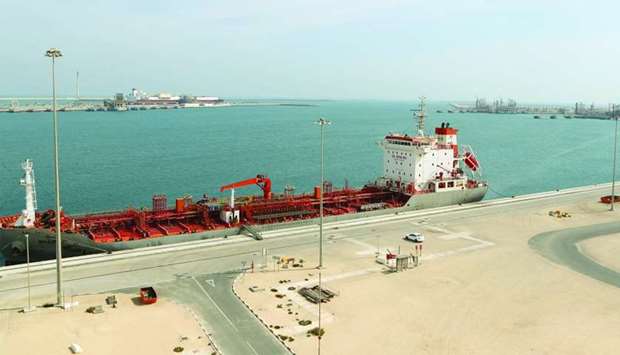Qatar accounted for bulk of the 36.3mn tonnes LNG supplies to Asia from the Middle East in 2019, the International Gas Union has said in its latest report.
Asia has the third largest liquefied natural gas trade flow from the Middle East, IGU noted in its ‘2020 World LNG’ report.
There were also significant flows from the Middle East to Asia Pacific, which was the second largest trade flow last year, but has now settled at 31.2mn tonnes.
A lot of the trade flow that used to go to Asia instead moved to Europe in 2019 as prices went down. Intra-Middle East trade was only 3mn tonnes.
Qatar managed to maintain its position as the largest exporter in the world, exporting 77.8mn tonnes in 2019, closely followed by Australia who exported a total of 75.4mn tonnes, an increase of 13% year-on-year, driven by the start-ups of Ichthys LNG T1-2 (8.9mn tonnes) and Prelude FLNG (3.6mn tonnes). The US overtook Malaysia as the third largest exporter, and added a record of 13.1mn tonnes, an increase of 63% as Corpus Christi LNG T1-2 (9mn tonnes), Cameron LNG T1 (4mn tonnes), Freeport LNG T1 (5.1mn tonnes), Sabine Pass T5 (4.5mn tonnes) and Elba Island T1-3 (0.75mn tonnes) started up.
Russia is now the fourth largest exporter of LNG, with 29.3mn tonnes of export in 2019 as Yamal LNG T3 (5.5mn tonnes) and Vysotsk LNG (0.66mn tonnes) were commissioned and started exporting cargoes, an increase of 60% compared to 2018.
The largest global LNG trade flow route continues to be intra-Asia Pacific trade (77.3mn tonnes), driven mainly by continued ramp up in exports from Australia, and to a lesser extent additional exports from Papua New Guinea and Malaysia, into the largest market of the world – Japan, as well as a large flow into Singapore, Indonesia, Thailand and South Korea. Interestingly, 3.6mn tonnes was intra-Indonesian trade. Most of the remaining supply out of Asia Pacific ended up in Asia, being the second largest LNG trade flow in 2019 – 54mn tonnes with 28mn tonnes from Australia to China alone.
While Asia’s market share remained stable with support from China, Pakistan and Bangladesh, India’s demand growth was muted compared to the growth seen in 2018 and prior years (+1.5mn tonnes) with infrastructure development slower than expected, and imports into Chinese Taipei dropped by 0.2mn tonnes.
China’s growth in LNG imports slowed down on the back of slower coal-to-gas switching efforts, increased domestic production and an increase of renewables in the energy mix, the IGU said.
There were also significant flows from the Middle East to Asia Pacific, which was the second largest trade flow last year, but has now settled at 31.2mn tonnes.
A lot of the trade flow that used to go to Asia instead moved to Europe in 2019 as prices went down. Intra-Middle East trade was only 3mn tonnes.
Qatar managed to maintain its position as the largest exporter in the world, exporting 77.8mn tonnes in 2019, closely followed by Australia who exported a total of 75.4mn tonnes, an increase of 13% year-on-year, driven by the start-ups of Ichthys LNG T1-2 (8.9mn tonnes) and Prelude FLNG (3.6mn tonnes). The US overtook Malaysia as the third largest exporter, and added a record of 13.1mn tonnes, an increase of 63% as Corpus Christi LNG T1-2 (9mn tonnes), Cameron LNG T1 (4mn tonnes), Freeport LNG T1 (5.1mn tonnes), Sabine Pass T5 (4.5mn tonnes) and Elba Island T1-3 (0.75mn tonnes) started up.
Russia is now the fourth largest exporter of LNG, with 29.3mn tonnes of export in 2019 as Yamal LNG T3 (5.5mn tonnes) and Vysotsk LNG (0.66mn tonnes) were commissioned and started exporting cargoes, an increase of 60% compared to 2018.
The largest global LNG trade flow route continues to be intra-Asia Pacific trade (77.3mn tonnes), driven mainly by continued ramp up in exports from Australia, and to a lesser extent additional exports from Papua New Guinea and Malaysia, into the largest market of the world – Japan, as well as a large flow into Singapore, Indonesia, Thailand and South Korea. Interestingly, 3.6mn tonnes was intra-Indonesian trade. Most of the remaining supply out of Asia Pacific ended up in Asia, being the second largest LNG trade flow in 2019 – 54mn tonnes with 28mn tonnes from Australia to China alone.
While Asia’s market share remained stable with support from China, Pakistan and Bangladesh, India’s demand growth was muted compared to the growth seen in 2018 and prior years (+1.5mn tonnes) with infrastructure development slower than expected, and imports into Chinese Taipei dropped by 0.2mn tonnes.
China’s growth in LNG imports slowed down on the back of slower coal-to-gas switching efforts, increased domestic production and an increase of renewables in the energy mix, the IGU said.


